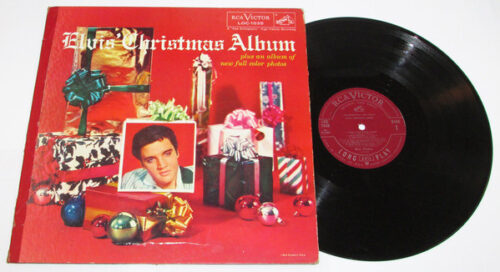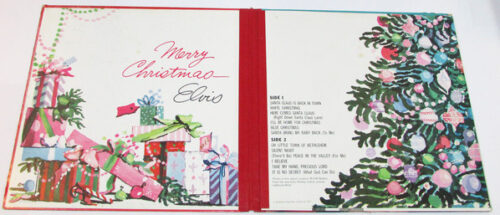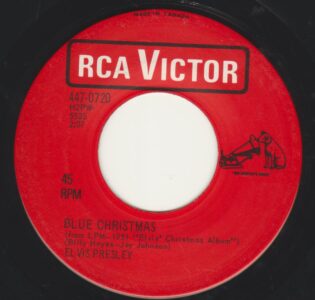#851: Blue Christmas by Elvis Presley
Peak Month: December 1957
4 weeks on Vancouver’s CKWX Red Robinson Teen Canteen chart
Peak Position #4
Peak Position on Billboard Hot 100 ~ #33 (2021)
YouTube: “Blue Christmas”
Lyrics: “Blue Christmas”
Elvis Aaron Presley was born on in a two-room house in Tupelo, Mississippi, on January 8, 1935. His twin brother, Jessie Garon Presley, was stillborn. When he was eleven years old his parents bought him a guitar at the Tupelo Hardware Store. As a result Elvis grew up as an only child. He and his parents, Vernon and Gladys, moved to Memphis, Tennessee, in 1948. The young Presley graduated from high school in 1953. That year he stopped by the Memphis Recording Service to record two songs, including “That’s When Your Heartaches Begin”. Elvis’ musical influences were the pop and country music of the time, the gospel music he heard in church and at the all-night gospel sings he frequently attended, and the black R&B he absorbed on historic Beale Street as a Memphis teenager. In 1954, Elvis began his singing career recording “That’s All Right” and “Blue Moon Of Kentucky” at Sun Records in Memphis.
In late 1955, his recording contract was sold to RCA Victor. In 1956 he had his first #1 record titled “Heartbreak Hotel.” He had a sound and style that uniquely combined his diverse musical influences and blurred and challenged the social and racial barriers of the time. Bill Haley & His Comets ushered in the rock ‘n roll into mainstream culture in 1955 when “Rock Around The Clock,” appeared in Blackboard Jungle – a film about juvenile delinquents and anti-social behavior in an inter-racial school. The song became an anthem for teenage rebellion.
However, it was Elvis in 1956 who ensured rock ‘n roll was here to stay with his swiveling hips and R&B infused songs with sexually suggestive lyrics. He had his first number one hit with “Heartbreak Hotel” in February 1956. He starred in 33 successful films, made history with his television appearances and specials, and knew great acclaim through his many, often record-breaking, live concert performances on tour and in Las Vegas. Globally, Elvis Presley has sold over one billion records, more than any other recording artist.
Between 1956 and 1957, Elvis Presley continued his chart-topping ways in Vancouver (BC) with “I Want You, I Need You, I Love You”, “Hound Dog”, “Don’t Be Cruel”, “Love Me Tender”, “Too Much”, “All Shook Up”, “(Let Me Be Your) Teddy Bear”, and “Mean Woman Blues” peaking at #1. During this chart-topping streak, one of Presley’s Top Ten hits in Vancouver was “(There’ll Be) Peace In The Valley“. Another was “Treat Me Nice”, a song featured in the film Jailhouse Rock. It was the B-side to the film’s title track.
While “Jailhouse Rock” was still in the Top Ten in Vancouver, “Blue Christmas” began to chart in early December ’57 on the Red Robinson Teen Canteen survey. The song was a track from Elvis’ Christmas Album.

“Blue Christmas” was written in 1948 by songwriters Billy Hayes and Jay W. Johnson. The original recording in 1948 was by Doye O’Dell. It is a tale of unrequited love during the Christmas holidays. Another country version by Jesse Rogers and his 49ers followed. In 1949 Hugo Winterhalter’s Orchestra and choir recorded the first pop version of the song. Similarly successful was Russ Morgan and his Orchestra with another fox trot arrangement. Winterhalter’s version peaked at #9 on Billboard‘s Records Most Played by Disk Jockeys chart and Morgan’s version reached #11 on Billboard‘s Best-Selling Pop Singles chart. Country singer Ernest Tubb had a number-one Country single on the Cashbox chart in early 1950.
In “Blue Christmas”, the singer notes the “decorations of red on a green Christmas tree, won’t be the same, dear, when you’re not here with me.” He’s going to spend his Christmas feeling blue without his used-to-be. Meanwhile, “you’ll be doing alright with your Christmas of white.” He has no Plan B, and will remain in the dumps through the holidays.

“Blue Christmas” was covered by Johnny Mathis, The Browns, who had a #28 hit in Vancouver with their cover in 1960. Other recording artists who’ve made covers include Chet Atkins, Bobby Vee, Paul and Paula, Jimmy Dean, Jim Reeves, the Beach Boys plaintiff recording, Jan and Dean, Pat Boone, Dean Martin, Bonnie Guitar, the Platters, Glen Campbell, The Ventures, the Partridge Family, Fats Domino, Andy Williams, Johnny Cash, Brenda Lee, Ringo Starr, John Denver, Chris Isaak, Harry Connick Jr., Jann Arden and others.
Billy Hayes was born in 1906 in New York City. He died in Brooklyn in 1993. “Blue Christmas” was his most successful song, while his other compositions were minor country hits. Little is known about Jay Johnson.
“Blue Christmas” was a track from Elvis’ Christmas Album which Red Robinson charted on his Teen Canteen survey on CKWX. It peaked at #4 in Vancouver. Elsewhere, Elvis’ cover of “Blue Christmas” shot to #2 in Worcester (MA), #5 in Sacramento (CA), #6 in La Crosse (WI), and #9 in Buffalo. “Blue Christmas” climbed to #10 in Green Bay (WI) during the Christmas after Elvis died in August 1977.
In December 1959, “Blue Christmas” returned to the Vancouver pop charts, peaking at #13 on CFUN. It charted again on CKWX to #28 in December 1960. On the Billboard Hot 100, “Blue Christmas” stalled at #107 in 1964. But didn’t chart in Vancouver.

But “Blue Christmas” cracked the Billboard Top 40 in 2019 and had a one-week chart run in early January 2021, with its highest position to date at #33.
Elvis kept on topping the charts into 1958 with “Don’t”, “Wear Your Ring Around My Neck” and “Hard Headed Woman”. He also starred in several films. His second film, Loving You, was released in 1957. Though it was not featured the film, the song “Have I Told You Lately That I Love You?” made it onto the Loving You Soundtrack album.
But during his chart-topping ways, he got a letter from Uncle Sam. Sergeant Elvis Presley served with the U.S. Army from March 24, 1958, to March 2, 1960. Meanwhile, Presley managed to climb to the top of the charts once in 1959 with “Big Hunk o’ Love”.
His return to civilian life saw a return to a string of successful single, album and film releases. From April 1960 to March 1961, Elvis topped the Billboard Hot 100 with “Stuck On You, “It’s Now Or Never,” “Are You Lonesome Tonight?” and “Surrender” for a total of 17 of 52 weeks in that timeframe. The album from his first film on return from serving in Germany, G.I. Blues, was a best-seller at the box office (#2 on Variety Magazine for the year 1960) and a number one album in October 1960. He released His Hand In Mine, a collection of sacred gospel music and in November, 1960, began to record his 6th studio album, Something For Everybody. It went on to become his 13th hit album.
Presley continued to have major hits in 1961-62. In Vancouver he topped the charts with “Marie’s The Name (His Latest Flame)”, “Little Sister” and “Good Luck Charm”. Other Top Ten hits included “Can’t Help Falling In Love” and “She’s Not You”. In 1962 Presley released his seventh studio album, Potluck. From that album the song “Kiss Me Quick” would peak at #34 on the Billboard Hot 100 in 1964. But his song, “Suspicion”, climbed onto the CFUN chart in the summer of 1962. Also in 1962 Elvis was filming a number of movies. The first to be released in the summer of ’62 was Kid Galahad, which included the song “King Of The Whole Wide World”.
His next film, Girls! Girls! Girls!, was released in late October. However, the debut single from the soundtrack, “Return To Sender”, was released in September prior to the film appearing in theaters. In Vancouver (BC) the title track from the film, “Girls! Girls! Girls!” also charted on the C-FUNTASTIC FIFTY.
Elvis continued to enjoy more Top Ten hits between 1963 and 1965. His most notable hits were “One Broken Heart For Sale”, “(You’re The) Devil In Disguise”, “Ain’t That Loving You Baby”, “Such A Night” and “Crying In The Chapel”. Less successful in the USA was “Witchcraft” which stalled at #32 on the Billboard Hot 100. But in Vancouver, the song peaked at #4.
After 1965, Elvis found it increasingly challenging to enter the Top 30. Between the end of 1965 and the winter of 1968 Presley released 22 singles and only four of these made the Billboard Hot 100’s Top 30. But in 1969, Presley had his best year since 1962 charting three singles into the Top Ten with “In The Ghetto”, “Suspicious Minds” and “Don’t Cry Daddy”. Between 1970 and 1983 Elvis released 36 singles, including eight posthumous singles. Of these, “Burning Love” and “The Wonder Of You” were his most successful and six others made the Top 20 on the Billboard charts.
Over his recording career Elvis Presley earned 14 Grammy Award nominations including for Record of the Year with “A Fool Such As I” (1959) and “Are You Lonesome Tonight” (1960) and won six Hall of Fame Awards. After his comeback tour in 1968 Presley had continued to tour extensively, with 168 concerts in 1973, a pace he kept through the mid-70’s. By 1976 he was suffering from multiple ailments: glaucoma, high blood pressure, liver damage, and an enlarged colon, all believed to be related to prescription drug abuse. He died on August 16, 1977, and a funeral was attended by over 80,000 mourners. His legacy continues to live on. There were also numerous sightings of Elvis including around the 40th anniversary of his death in 2017.
December 25, 2021
Ray McGinnis
References:
graceland.com (Elvis bio)
“Elvis Presley: Rock’s First Icon,” Rolling Stone, September 22, 1977.
Paul Lichter, The Boy Who Dared to Rock: The Definitive Elvis, (Garden City, NY: Dolphin Books, 1978).
Elizabeth Nix, “7 Fascinating Facts About Elvis Presley,” History.com, July 1, 2014
Wendy Sauer, Elvis Presley: A Complete Reference, (Jefferson, NC: McFarland, 1984).
“Red Robinson Teen Canteen Survey,” CKWX 1130 AM, Vancouver, BC, December 8, 1957.
For more song reviews visit the Countdown.

Leave a Reply